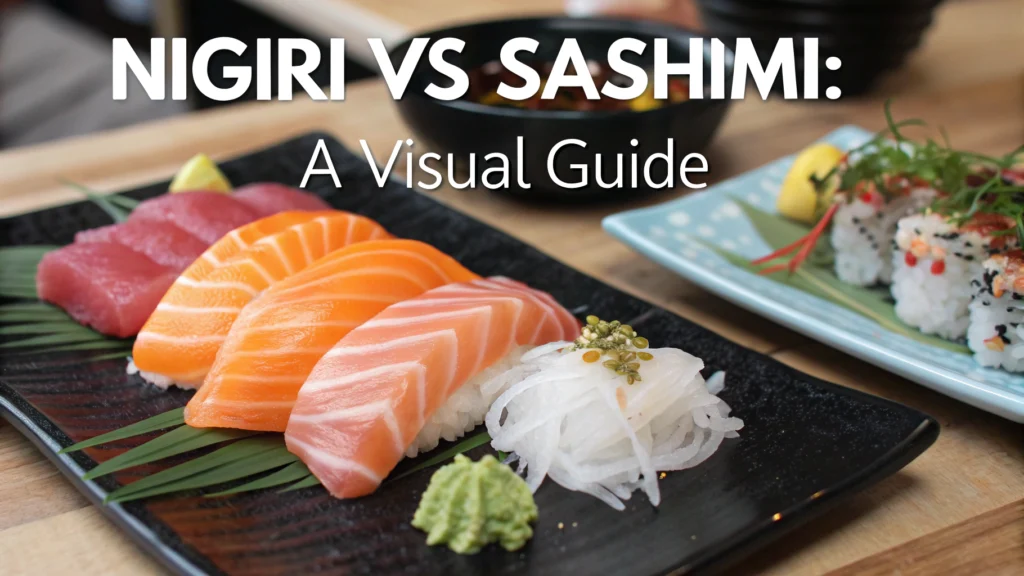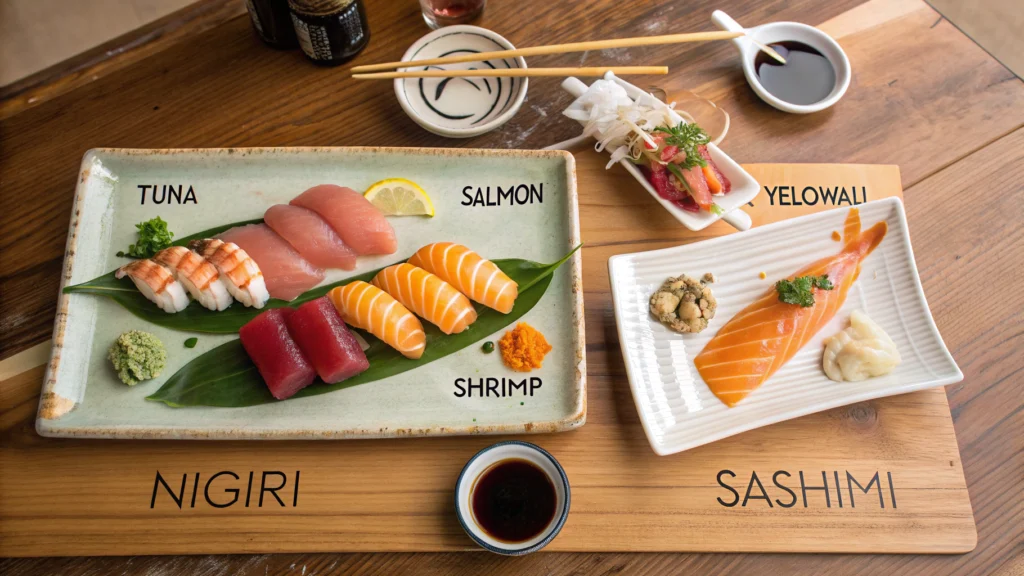Nigiri vs Sashimi

When diving into the world of Japanese cuisine, two preparations often confused by newcomers are nigiri and sashimi. While both showcase the pristine quality of raw fish, nigiri vs sashimi represents two distinct culinary traditions with different preparations, presentations, and eating experiences. This comprehensive guide will walk you through everything you need to know about these iconic Japanese delicacies.
What is Nigiri? Origin and History
Nigiri, a staple in traditional Japanese sushi, features a compact mound of vinegared rice expertly shaped by hand and crowned with a delicate slice of raw fish or seafood. The name “nigiri” is derived from the Japanese verb nigiru, meaning “to grip” or “to mold,” highlighting the careful hand-formed technique used to craft each piece.
Nigiri originated in the Edo period (1603-1868) in Tokyo (then called Edo). As a bustling port city, Edo had abundant access to fresh fish, leading to the development of this quick, hand-formed sushi style. Historically, nigiri was one of the first forms of “fast food” in Japan, sold at street stalls to busy workers who needed a quick meal.
The creation of nigiri is credited to a chef named Hanaya Yohei, who in the 1800s began serving freshly caught fish from Tokyo Bay over vinegared rice. This innovation eliminated the fermentation process used in earlier sushi forms, creating an immediately edible delicacy that showcased the fish’s freshness.
What is Sashimi? Origin and History
Sashimi consists of thinly sliced raw fish or meat, served without rice. The term “sashimi” literally means “pierced body” in Japanese, possibly referring to the traditional practice of serving the fish with its tail or fin to identify the type being consumed.
Sashimi’s origins predate written Japanese history, with roots possibly extending back to the 14th century. Unlike nigiri, which was developed as a street food, sashimi began as a dish for the nobility and samurai class. It represents one of Japan’s purest culinary art forms, focusing entirely on the quality and presentation of the raw ingredient.
During Japan’s Muromachi period (1336-1573), the principles of minimalism and precision in food preparation gained prominence, and sashimi became an expression of these aesthetic values. The dish exemplifies the Japanese culinary philosophy of highlighting an ingredient’s natural flavor rather than masking it with seasonings or cooking methods.
Nigiri vs Sashimi: Detailed Comparison

Composition and Preparation
Nigiri:
- Features a base of vinegared rice (sushi rice)
- The rice is hand-pressed into a rectangular mound
- A wasabi dab is often placed between the rice and fish
- The fish is typically cut in specific proportions to the rice
- Requires balancing the flavors of rice and fish
Sashimi:
- Contains no rice
- Consists solely of precision-cut raw fish or seafood
- Cut into specific shapes depending on the type of fish
- Requires exceptional knife skills for proper texture
- Often cut against the grain for optimal tenderness
Fish Selection and Cutting Techniques of Nigiri vs Sashimi
Nigiri:
- Fish cuts are typically thinner and smaller than sashimi
- Must complement the rice in both flavor and texture
- Often brushed with nikiri (sweet soy) or other glazes
- May be lightly seared (aburi-style) or marinated
- Cut to specific dimensions to cover rice properly
Sashimi:
- Uses larger, thicker cuts to showcase the fish’s texture
- Employs specialized cutting styles for each fish type:
- Hira-zukuri (rectangular slice) for tuna
- Usuzukuri (thin slice) for white fish
- Sogizukuri (thinly sliced at an angle) for firm fish
- Requires the freshest, highest-quality fish available
- Must stand on its own without rice to balance flavors
Presentation Styles
Nigiri:
- Typically served in pairs on shared plates
- Arranged in a neat, orderly fashion
- The fish drapes over the rice, often extending slightly beyond edges
- Garnishes are minimal to avoid distracting from the rice-fish harmony
- Often part of a larger sushi assortment
Sashimi:
- Artistically arranged on decorative plates
- Often presented with elaborate carving and garnishes
- Typically served with a shiso leaf, carved daikon radish, and fresh wasabi
- Arrangement may mimic natural forms or landscapes
- Usually served as a separate course before other dishes
Eating Etiquette
Nigiri:
- Traditionally eaten with hands (though chopsticks are acceptable)
- Turned upside down and dipped fish-side into soy sauce (not rice-side)
- Consumed in one bite to experience the balanced flavors
- The wasabi is already applied between rice and fish by the chef
Sashimi:
- Always eaten with chopsticks
- Dipped lightly in soy sauce, sometimes with wasabi mixed in
- Each piece is typically enjoyed individually
- Palate cleansers like ginger are used between different fish types
Regional and Cultural Significance OF Nigiri vs Sashimi
Nigiri is emblematic of Tokyo cuisine, representing the city’s fast-paced lifestyle and access to fresh seafood from Tokyo Bay. Its popularity spread throughout Japan during the 20th century and eventually worldwide as Japanese cuisine gained international recognition.
Sashimi, by contrast, is deeply rooted in Japanese cultural aesthetics and represents the highest level of culinary craftsmanship. It’s often served at the beginning of a traditional kaiseki (multi-course) meal to showcase the chef’s skill and the quality of ingredients.
Both preparations have gained immense popularity globally, though traditional sushi chefs (itamae) undergo years of training to master the precise techniques required for each.
Nutritional Differences of Nigiri vs Sashimi
Nigiri:
- Higher in carbohydrates due to the rice component
- Contains more calories than sashimi
- Provides a balance of protein and carbohydrates
- The rice vinegar offers digestive benefits
- More filling as a meal option
Sashimi:
- Low in carbohydrates
- High in protein and omega-3 fatty acids
- Lower calorie option overall
- Pure source of fish nutrients without rice
- Often considered a protein-focused appetizer rather than a complete meal
FAQs About Nigiri vs Sashimi
1. Is nigiri considered a type of sushi?
Yes, nigiri is a style of sushi characterized by hand-pressed rice topped with fish. The term “sushi” refers to dishes featuring vinegared rice, while sashimi contains no rice and isn’t considered sushi.
2. Which is healthier, nigiri or sashimi?
Sashimi is generally considered healthier for low-carb diets as it contains only protein without rice. However, nigiri offers a more balanced nutritional profile with both protein and carbohydrates.
3. What fish varieties work best for nigiri vs sashimi?
Both preparations use similar fish, including tuna, salmon, yellowtail, and mackerel. However, certain delicate white fish like flounder or sea bream often shine better as sashimi, while fattier fish like salmon or eel work wonderfully as nigiri.
4. How fresh must fish be for nigiri and sashimi?
Extremely fresh. Both require sashimi-grade fish (the highest quality), though sashimi places even greater emphasis on freshness since there’s no rice to complement the fish.
5. Can vegetarians enjoy nigiri or sashimi?
Traditional nigiri can be made with plant-based toppings like avocado, tofu, or pickled vegetables. Vegetarian “sashimi” made from konjac, carrot, or other vegetables exists but isn’t considered authentic sashimi.
6. What’s the proper way to eat nigiri?
The traditional method is using your fingers, turning the nigiri upside down, and dipping only the fish (not the rice) lightly in soy sauce before consuming it in one bite.
7. How is sashimi different from carpaccio or crudo?
While all feature raw preparations, sashimi focuses on clean, straight cuts of fish with minimal seasoning. Italian carpaccio typically uses beef sliced paper-thin with olive oil, while crudo often incorporates citrus and herbs.
8. What accompaniments are traditionally served with each(Nigiri vs Sashimi)?
Nigiri typically comes with pickled ginger (gari) and soy sauce, with wasabi already applied under the fish. Sashimi is served with fresh wasabi, soy sauce, and often shredded daikon radish.
9. Which is more expensive at restaurants(Nigiri vs Sashimi)?
Sashimi is typically more expensive per piece than nigiri, as it uses larger cuts of fish without the rice filler. High-end sashimi featuring premium fish like otoro (fatty tuna belly) commands the highest prices.
10. Can beginners to Japanese cuisine appreciate both equally?
Many newcomers find nigiri more approachable due to the familiar rice component and smaller fish portion. The rice also helps temper the texture and flavor of raw fish for those unaccustomed to it, while sashimi presents a more direct experience of raw fish.
you may like also

